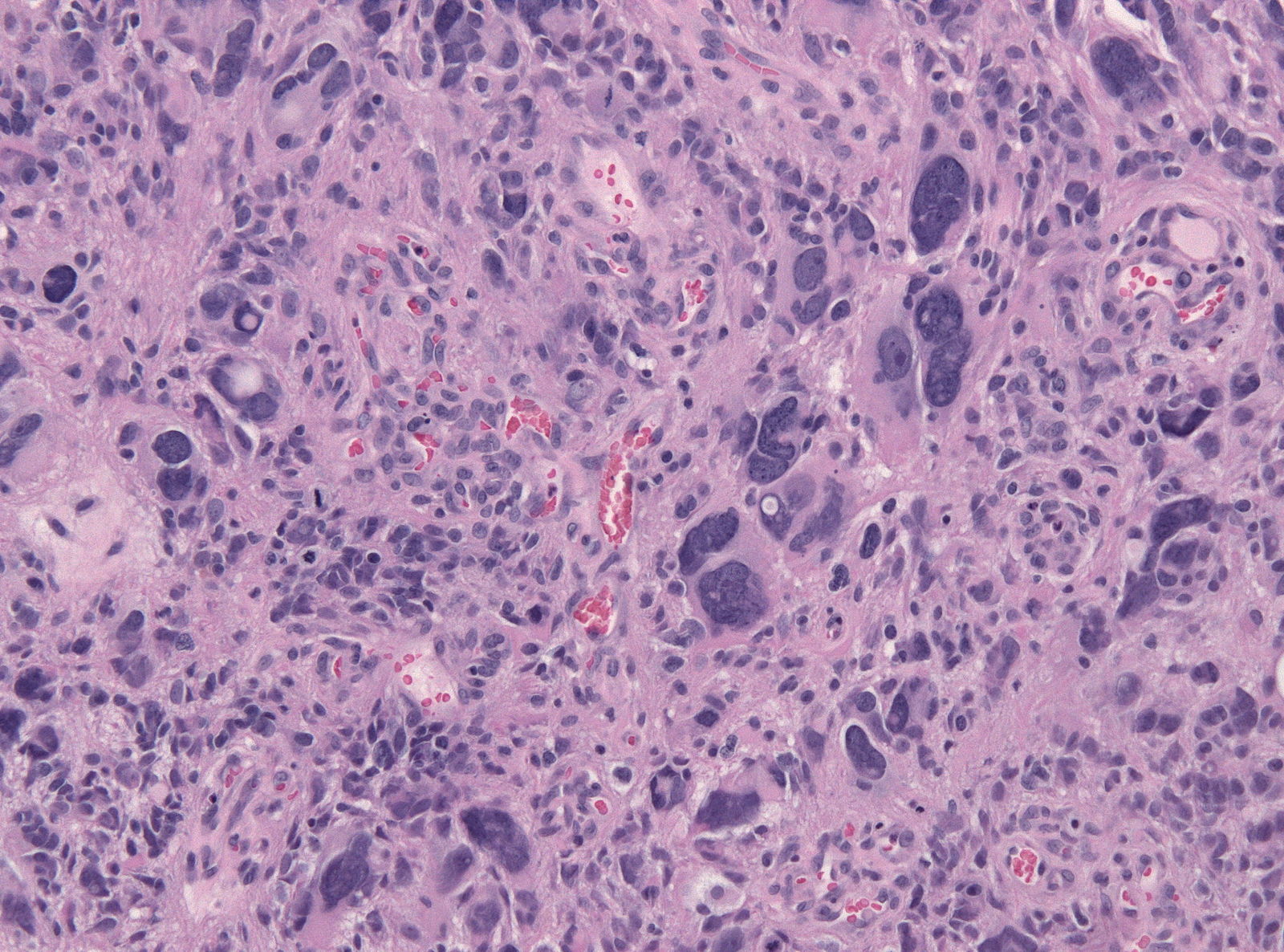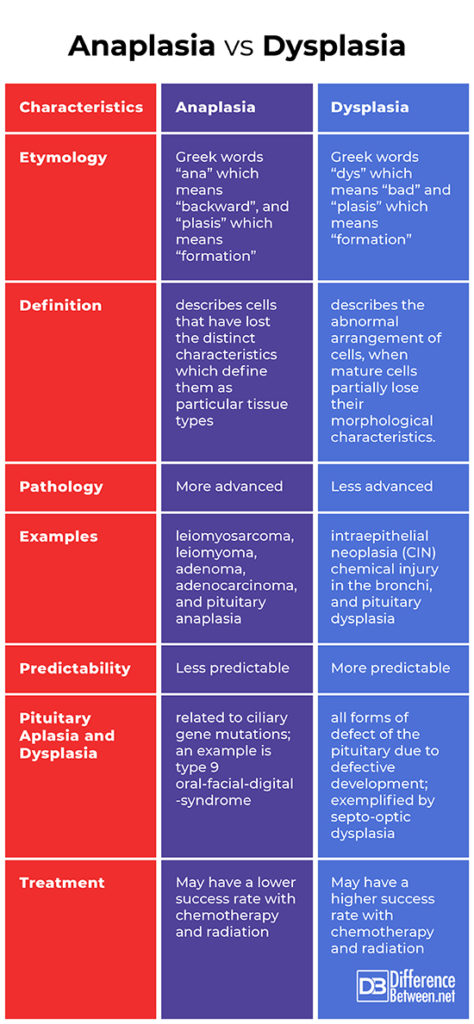Difference Between Anaplasia and Dysplasia
Anaplasia and dysplasia are both concerned with aberrant cell growth; hence, it is understandable why they may be confused with each other. These are terms in pathology which refer to how tissue cells appear through a microscope. They are generally associated with the formation of tumors. Their specific distinction is actually vague and complex. Anaplasia is defined as a cellular state of poor differentiation. Similarly, dysplasia is defined as abnormal cell development or growth.
As to their differences, pathologists rely on their experience and knowledge in utilizing these medical terms. Anaplasia refers to the lack of differentiation or maturity of cells; this condition may be seen as irreversible. On the other hand, dysplasia is generally on a less advanced stage as it is seen as a partial loss of mature cells’ morphological characteristics. The following discussions further delve into their differences.

What is Anaplasia?
Anaplasia came from the Greek words “ana” which means “backward”, and “plasis” which means “formation”; it literally means “to form backwards”. It describes cells which have lost the distinct characteristics which define them as particular tissue types. It is a cellular state of poor differentiation These cells are called anaplastic.
As compared to normal cells which become more mature with each division, anaplastic cells revert to a stem-cell like phase; they usually appear distorted. They may rapidly divide and then go dormant. Since a cell in this state does not function normally, it also produces cells which manifest anaplasia, until a tumor is developed. Anaplasia leads to the unpredictable nature of cancer cells; this makes chemotherapy and radiation treatments less effective.
Examples of anaplasia include the following:
- Leiomyosarcoma – It is a malignant smooth muscle tumor.
- Leiomyoma- A benign smooth muscle tumor.
- Adenoma-A benign glandular tumor.
- Adenocarcinoma-A malignant glandular tumor.

What is Dysplasia?
Dysplasia came from the Greek words “dys” which means “bad” and “plasis” which means “formation”. It describes the abnormal arrangement of cells or atypical cell development which may become precursor lesions to cancer. However, other dysplasias are harmless and spontaneously deteriorate. This state is less pathological as compared to anaplasia. This is generally assessed based on the irregularity of the nuclear envelope and chromatin distribution.
Examples of dysplasia include the following:
- Intraepithelial neoplasia (CIN) – It is a dysplasia of the uterine cervix which may lead to cervical cancer.
- Chemical injury in the bronchi – It may be observed among cigarette smokers wherein there are somatic genetic changes.
- Septo-optic dysplasia – It is characterized by the underdevelopment of the pituitary gland, abnormal development of the brain, and under-development of the optic nerves.
Difference between Anaplasia and Dysplasia
Etymology
Anaplasia came from the Greek words “ana” which means “backward”, and “plasis” which means “formation”; it literally means “to form backwards”. Dysplasia came from the Greek words “dys” which means “bad” and “plasis” which means “formation”.
Definition
Anaplasia describes cells that have lost the distinct characteristics which define them as particular tissue types. On the other hand, dysplasia describes the abnormal arrangement of cells. It also pertains to a state when mature cells partially lose their morphological characteristics.
Pathology
Anaplasia is often considered as being in a more advanced stage of pathology as the loss of maturity and differentiation are more evident. Anaplastics may also be seen as irreversible. On the other hand, dysplasia is a less advanced stage as other dysplastics are harmless and spontaneously deteriorate.
Examples
The examples of anaplasia include leiomyosarcoma, leiomyoma, adenoma, and adenocarcinoma. The examples of dysplasia include intraepithelial neoplasia (CIN) and chemical injury in the bronchi.
Predictability
Anaplastic cells are less predictable, they may rapidly divide and then go dormant. On the contrary, the behavior of dysplastic cells is more predictable.
Pituitary Aplasia and Dysplasia
Pituitary aplasia is a rare condition which is related to ciliary gene mutations. An example of this is type 9 oral-facial-digital-syndrome, its symptoms include highly arched palate, strabismus, polydactyly, and bifid tongue. In comparison, pituitary dysplasia refers to all forms of defect of the pituitary due to defective development. This is exemplified by septo-optic dysplasia, a condition characterized by the underdevelopment of the pituitary gland, abnormal development of the brain, and under-development of the optic nerves.
Treatment
Treatments such as chemotherapy and radiation are more successful for dysplastic cells since they are more predictable than anaplastic cells.
Anaplasia vs Dysplasia

Summary
- Anaplasia and dysplasia are terms in pathology which refer to how tissue cells appear through a microscope.
- Anaplasia describes cells which have lost the distinct characteristics which define them as particular tissue types.
- Dysplasia describes the abnormal arrangement of cells which may become precursor lesions to cancer.
- “Ana” means “backward” while “dys” which means “bad”.
- The pathology of anaplasia is more advanced as compared to dysplasia.
- The examples of anaplasia include leiomyosarcoma, leiomyoma, adenoma, and adenocarcinoma while those of dysplasia include intraepithelial neoplasia and chemical injury in the bronchi.
- The behavior of dysplastic cells is more predictable than that of anaplastic cells.
- Pituitary aplasia is related to ciliary gene mutations while pituitary dysplasia is all forms of defect of the pituitary due to defective development.
- The treatments for anaplastic cells tend to be less successful as they are less predictable.
- Difference Between Hematoma and Melanoma - February 9, 2023
- Difference Between Bruising and Necrosis - February 8, 2023
- Difference Between Brain Hematoma and Brain Hemorrhage - February 8, 2023
Search DifferenceBetween.net :
Leave a Response
References :
[0]Image credit: https://live.staticflickr.com/3768/9277034737_0c85905efb_b.jpg
[1]Image credit: https://commons.wikimedia.org/wiki/File:Glioblastoma_anaplastic_cells_HE.jpg
[2]Donadoni, Carla. Structural Studies on the anaplastic lymphoma kinase. Mauritius: Lap Lambert Academic Publishing, 2015. Print.
[3]Itzkowitz, Steven and Harpaz, Noam. “Diagnosis and Management of Dysplasia in Patients with Inflammatory Bowel Diseases”. Gastroenterology. May 2004. https://www.gastrojournal.org/article/S0016-5085(04)00460-3/abstract (accessed March 23, 2020)
[4]Sarnat, Harvey. “Pituitary Aplasia, Dysplasia, and Ectopic Neurohypophysis”. Neurology Medlink. March 23 2019. https://www.medlink.com/article/pituitary_aplasia_dysplasia_and_ectopic_neurohypophysis (accessed March 24, 2020)
